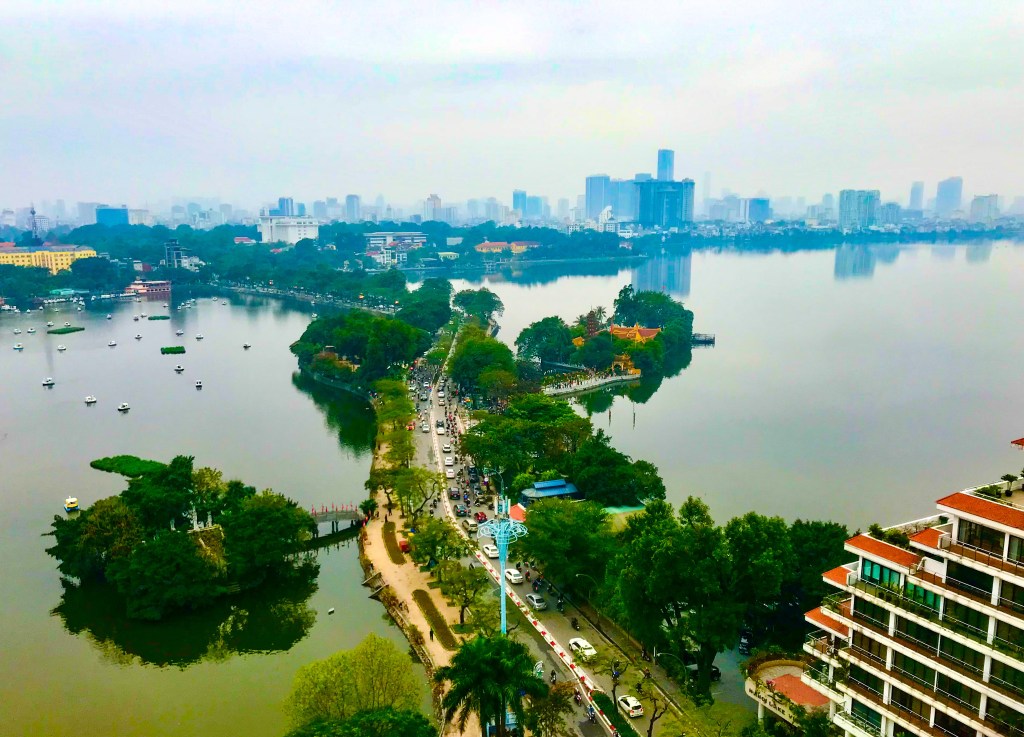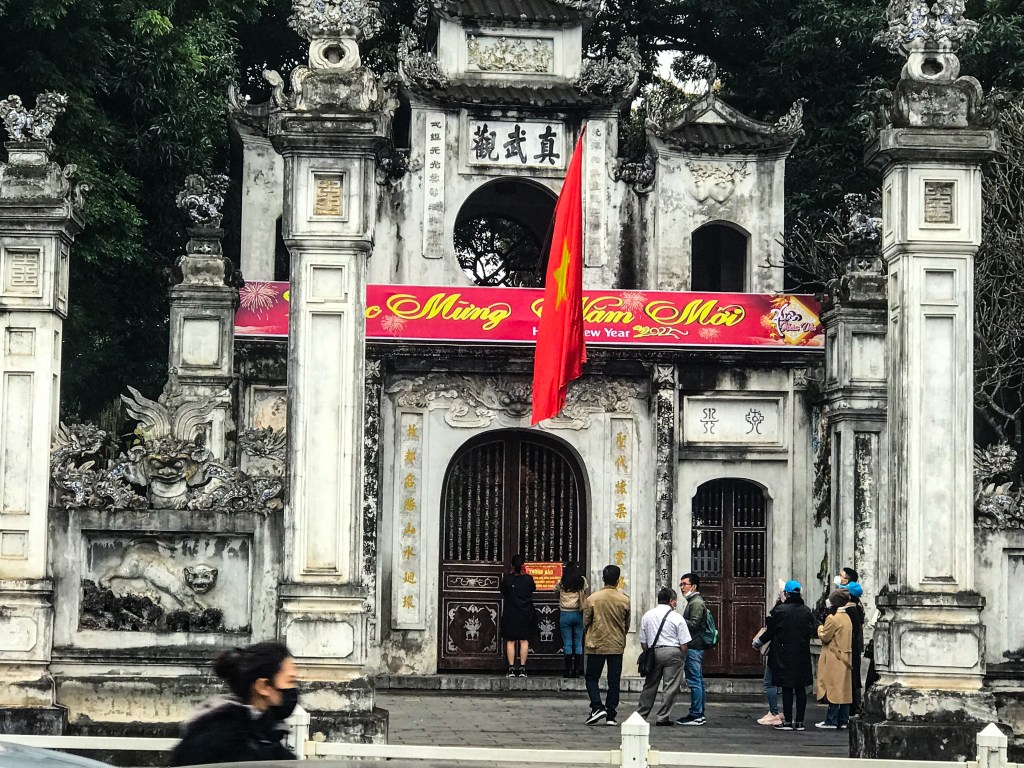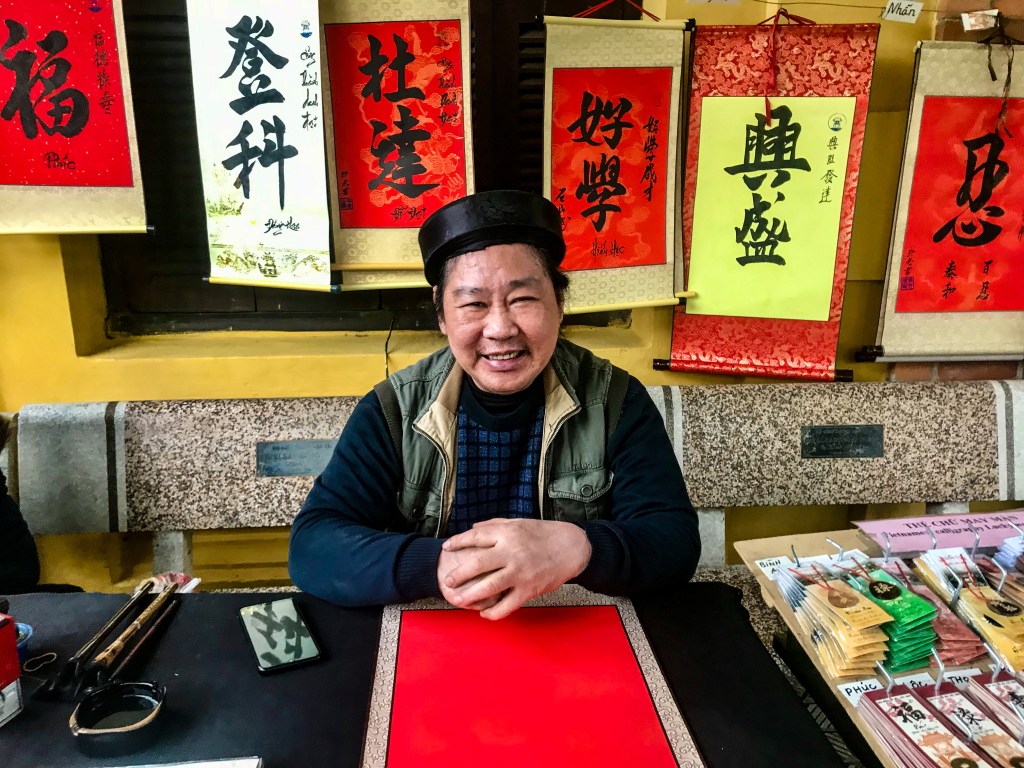Vietnam’s capital city serves up history and religion on a walk past West Lake to the Ba Dinh district.

The southerly view from the rooftop lounge at the Pan Pacific Hanoi hotel is enough to take one’s breath away — even under an overcast sky.
Despite a subtropical winter chill outside, the causeway separating Hồ Tây (West Lake) and Hồ Trúc Bạch appeared from my 20th-story perch to be buzzing with life. The verdure that framed the boulevard called Thanh Niên, partially obscuring a bumper-to-bumper line of cars and motorbikes, gave way to colorful bridges and pagodas on tiny islets, waterfront seafood restaurants and ice-cream shops.
At the heart of my panorama was a broad pedestrian promenade that extended from Hanoi’s expatriate-friendly Tay Ho district to the colonial-era Presidential Palace, a prominent burnt-yellow landmark of the Ba Đình precinct. And in the further distance, somewhat more to the west, rose the skyscrapers of the city’s modern financial center.
Seventeen kilometers (over 10 miles) around, West Lake is the largest of many lakes in Vietnam’s capital. Indeed, the abundance of freshwater tarns might remind a visitor of Minneapolis. A paved pathway that circles Hồ Tây makes it especially popular with joggers and bicyclists, some of whom pause at the lovely Tay Ho Pagoda (about 1 km northwest of the Pan Pacific Hanoi) to request favors from Buddhism’s “mother goddess,” Quan Am.

The noble path
Opened in 2006, the Pan Pacific Hanoi is one of the capital’s luxury bargains with surprisingly moderate (albeit pandemic-influenced) room rates. The tab includes not only immaculate guest rooms, fine restaurants, indulgent amenities and state-of-the-art facilities, but also the best breakfast I’ve enjoyed anywhere in Vietnam: a gourmet buffet with meal selections ranging from American to Korean, French to Japanese, and traditional Vietnamese. Learn more about the Pan Pacific Hanoi here.
I set out one morning to conquer the causeway, its charms beckoning me from The Summit lounge to the pavement far below. Thanh Niên boulevard led me past one picturesque pilgrimage possibility (a bridge to a tiny temple on an islet in Trúc Bạch) to another — the Trấn Quốc Pagoda, oldest in this ancient city.

Built in the 6th Century on the periphery of the city, on the Red River, the pagoda and its multiple shrines (containing the ashes of prominent Buddhist monks) was relocated in 1615 to Kim Ngu (Golden Fish) Island. It hasn’t undergone a major renovation for more than two centuries, but a veneer of orange paint on its brick structures gives it a modern appearance.
I approached via a broad bridge that took me directly to the sacred grounds. As a student of Buddhism, I immediately recognized the eight-spoked wheel, a symbol of the Noble Eightfold Path of Buddhist doctrine with its emphasis on proper perspective, resolve, speech, conduct, livehihood, effort, mìndfulness and awareness.
Widely visible were statues and stone engravings of lotus flowers, emblematic of enlightenment, achievement, and purity of mind, body and speech. Throngs of worshippers crowded the site, pausing at altars bedecked with flowers and fruit, lighting aromatic incense sticks that sent their smoke heavenward from giant urns.

Of turtles and snakes
At the south end of Than Niên boulevard, a popular riverboat coffee shop floats on Trúc Bạch lake near the spot where a young U.S. naval officer named John McCain was pulled from his crashed bomber in 1967. (Read about that here.) Two centuries earlier, there had been an imperial palace on the lakeshore; it later became a reform school, of sorts, for royal concubines who sought amusement beyond the king’s bedroom and were thereafter condemned to a life weaving white silk.
The monks of the Taoist temple of Quán Thánh might have commiserated. They offered their prayers just across the lake from the palace. Built during the reign of Emperor Lý Thái Tổ (1010–1028) and dedicated to Trấn Vũ, the God of the North, the temple was strategically located to defend the ancient city against evil spirits.
As Trấn Vũ’s symbols of power are the tortoise, for protection, and serpent, for wealth, I found numerous images of both animals throughout this temple … as well as a bronze bell and statue of Trấn Vũ dating from 1677. Hanoians come here under the full and new moon to pray for health and happiness.

Where the dead tread
Crossing Quán Thánh street, I found myself in Hanoi’s Ba Đình neighborhood, dominated by the green expanse of the Ho Chi Minh Mausoleum Complex. Free of vehicular traffic, cloaked with botanical gardens, it can easily take a full day of exploration in its own right. Apart from the mausoleum itself, structures include a museum, a historic pagoda, multiple memorials and monuments, and a small village where Uncle Ho lived from 1954 until his death in 1969.
The first building I encountered on my walk from the Pan Pacific, before even crossing onto the campus, was the Presidential Palace. Built by the French for the governor-general of Indochina in 1906, the opulent Beaux-Arts edifice was restored and painted yellow under the Communist administration. It isn’t open to the public but is used for official receptions.

It’s the mausoleum, though, that people come to see. Groups of patriotic Vietnamese venture from all over the country to honor Hồ Chí Minh (1890-1969), the political mind behind modern Vietnam, known to many merely as Bác Hồ (“Uncle Ho”). Although the man himself had requested a simple cremation and a scattering of his ashes, he has been embalmed here in this grand marble tomb, his glass sarcophagus set deep within a maze of well-guarded stairways and corridors.
Those who dare to enter — and, yes, this included me (more about it here) — are subjected to a security screening followed by a long stroll across the grounds of the complex, where patriotic music is played on oversized video screens to those who queue for entrance. At the entrance to the mausoleum, white-uniformed militia make it clear that cameras and cell phones are not tolerated within the building.

They are, however, welcomed in the Ho Chi Minh Museum, a fine survey of the man’s life for anyone who may not be thoroughly acquainted. Exhibits in the three-story concrete structure are not consistently translated, however, and admission for foreigners is notably higher than for Vietnamese nationals. Of most interest to me were a timeline of Ho’s life, including his early travels in Europe and America, and photographs and documents that shed light on the seeds of Marxist philosophy in Southeast Asia.
Bác Hồ lived most of his final years in a traditional stilt house, overlooking a fish pond and set in a beloved garden often tended by the leader himself. Special efforts have been made to maintain it as it appeared more than 50 years ago, the garden still productive, the pond still filled with koi fish.
Plexiglas views into Ho’s library and bedroom give an insight into his life. But even a man who chose a humble lifestyle could have his weaknesses. In Ho’s case, it was cars. Three of his favorites are displayed in a “showroom” garage in the adjacent village, where Ho also attended party meetings and took his meals.

A single pillar
Predating every other site on the grounds of the mausoleum complex is the One Pillar Pagoda, which stands just below the Ho Chi Minh Museum. It is built of wood on a single stone pillar. The design is said to bring to mind a lotus blossom rising from a sea of sorrow.
The pagoda is ascribed to Emperor Ly Thai Tong (1028-1054), who yearned for an heir decades into his reign. In a dream, he was handed a boy child by Quan Am, the goddess of mercy to whom he had prayed. In 1049, after he had married a young peasant girl who bore him a son, he directed this construction as a way to express his gratitude to the goddess.

This isn’t Ly’s pagoda, however. The vengeful French, as they evacuated Hanoi after their expulsion in 1954, destroyed the original. It was subsequently rebuilt by the new Viet Minh government.
My fondest memory of my One Pillar visit was watching the burning of effigies during the Lunar New Year (Tết) holiday. Devotees of Quan Am streamed into the sanctuary to offer prayers, carrying with them paper effigies representing ancestors. Supplications accomplished, the dolls were then carried to a fiery brick oven in an outer courtyard, where they were burned along with mock money and other joss to assure the welfare in the afterlife of those who came before.

Outside the pagoda and museum, a line of shops offered light meals and souvenirs. In particular, I was drawn to a jolly-faced man whose craft was calligraphy: In broad brush strokes, for a small fee, he would paint mots of wisdom in traditional Chinese characters to hang on walls from Haiphong to Houston.
I was traveling light and didn’t want to crumple his fine artwork in a carry-on bag.


